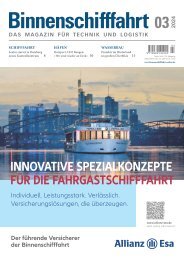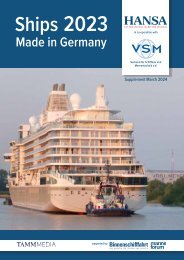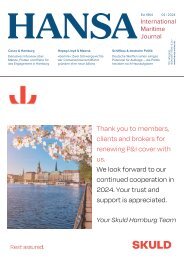HANSA 05-2017
Special Focus: NorShipping 2017 | HullPic Review | COMPIT Preview | Leonhardt & Blumberg | Sewol salvage | Tugs | German Banks | Tanker | Maritime Politics | Offshore Tender
Special Focus: NorShipping 2017 | HullPic Review | COMPIT Preview | Leonhardt & Blumberg | Sewol salvage | Tugs | German Banks | Tanker | Maritime Politics | Offshore Tender
Create successful ePaper yourself
Turn your PDF publications into a flip-book with our unique Google optimized e-Paper software.
Nor-Shipping<br />
According to Statistics Norway, in Q4 of<br />
2016 the oil export rose to 8.6 mill. t. This<br />
is nearly twice the figure of Q4 2015.<br />
Located within the Bergen harbour district<br />
are marine oil refineries, a number<br />
of bunkering facilities and well-equipped<br />
workshops including slipways, dry docks<br />
and floating docks. The port privides<br />
cranes with lifting capacities of up to 125 t.<br />
In addition, ship agents like Greencarrier<br />
Shipping & Logistics, Nor Lines, Kuehne &<br />
Nagel, Bring Logistics, Sea Cargo Agencies<br />
and Wilhelmsen Agencies, have access to a<br />
wide range of equipment, including trucks<br />
with a lifting capacity of up to 42 t, terminal<br />
tractors and lorries.<br />
Depending on port infrastructure<br />
Norway has strong trade relations with the<br />
EU. According to the German Ministry of<br />
Foreign Affairs, more than 80% of the total<br />
Norwegian exports go to EU member states.<br />
On the other hand, EU member states account<br />
for 65% of Norway’s imports. The<br />
largest foreign trade partners are Germany,<br />
the UK, Sweden, the Netherlands, China<br />
and the USA. Norway owns 42% of the<br />
Western European conventional oil and gas<br />
reserves. Oil and gas products total to more<br />
than 60% of all Norwegian exports. Therefore,<br />
it is also necessary for the coun try to<br />
have a good port infrastructure.<br />
The Port of Grenland is owned by the<br />
municipalities of Bamble, Porsgrunn and<br />
Skien, and is environmentally certified to<br />
ISO 14001 standards. A wide range of cargo<br />
were handled there, for example dry<br />
bulk, wet bulk, general cargo, and containers,<br />
totaling 10.8 mill. t per year. The<br />
terminals have the capacity to host vessels<br />
up to 150,000 dwt. More than 2,500 ships<br />
call Grenland each year. At Tangen quay at<br />
Brevik Terminal coal ships with a length<br />
of 200 m can berth. The roro terminal has<br />
a length of 180 m and includes two roro<br />
Karmsund plans to become a logistc hub<br />
ramps, each with a width of 32 m. Railway<br />
tracks are located right down the quay. The<br />
terminal company, North Sea Terminals,<br />
operates the LoLo Breivik Terminal. According<br />
to Port of Grenland, it is among<br />
Norway’s largest roro terminals. It features<br />
facilities for lolo, roro and dry bulk handling.<br />
From Langesund Ferry Terminal<br />
Fjord Line has daily departures to Hirtshals,<br />
Stavanger and Bergen.<br />
The dry bulk quays at Portsgrunn include<br />
the crane quay with a length of 230 m<br />
at 6,70 m gauge, the deep water quay with a<br />
length of 175 m and a depth of 9.70 m and<br />
the 150 m long Tinfos quay at 6,70 m gauge.<br />
At Skien Harbour Terminal general cargo<br />
and dry bulk are handled. There is one<br />
135 m quay with a depth of 9.5 m and another<br />
with a length of 165 m with the same<br />
depth. The roro ramp measures 30 m. In addition<br />
the stone quay has a depth of 10 m.<br />
Oslo is Norway’s leading cargo and ferry<br />
port. 50 to 70 cargo or passenger vessels<br />
call this hub every week. In 2016, 81 cruise<br />
ships have docked with 155,000 visitors<br />
aboard. But this is a decrease compared<br />
to 2015 when 102 vessels with nearly<br />
200,000 passengers berthed. The cruise<br />
traffc centre includes four piers with<br />
lengths from 249 m to 345 m, all located<br />
close to the city centre.<br />
There are three daily ferry arrivals from<br />
Denmark and Germany. Ferry operator<br />
Color Line links the German port of<br />
Kiel with the Norwegian capital city and<br />
DFDS have a connection to Denmark. But<br />
Oslo also has a container handling facility.<br />
The Sjursøya Container Terminal is<br />
the largest of the country. It is operated<br />
by Yilport and has a throughput capacity<br />
of 300,000 TEU. Cargo is handled with<br />
two Konecranes gantry cranes with a liftig<br />
capacity of 64t and an outreach of 40m,<br />
that go across 15 rows of boxes. Kalmar<br />
delivered two more cranes with a capacity<br />
of 61t and an outreach for vessels with<br />
up to 18 rows. Kalmar also supplied eight<br />
RTGs with a lifting capacity of 50t each,<br />
two reachstackers with 45t lifting capacity<br />
and twelve terminal tractors. Two<br />
Linde-C90 and three Nissan-DX30 complete<br />
the terminal equipment. M<br />
Photo: Port of Bergen<br />
Source: Karmsund Port Authority<br />
<strong>HANSA</strong> International Maritime Journal – 154. Jahrgang – <strong>2017</strong> – Nr. 5 49


















